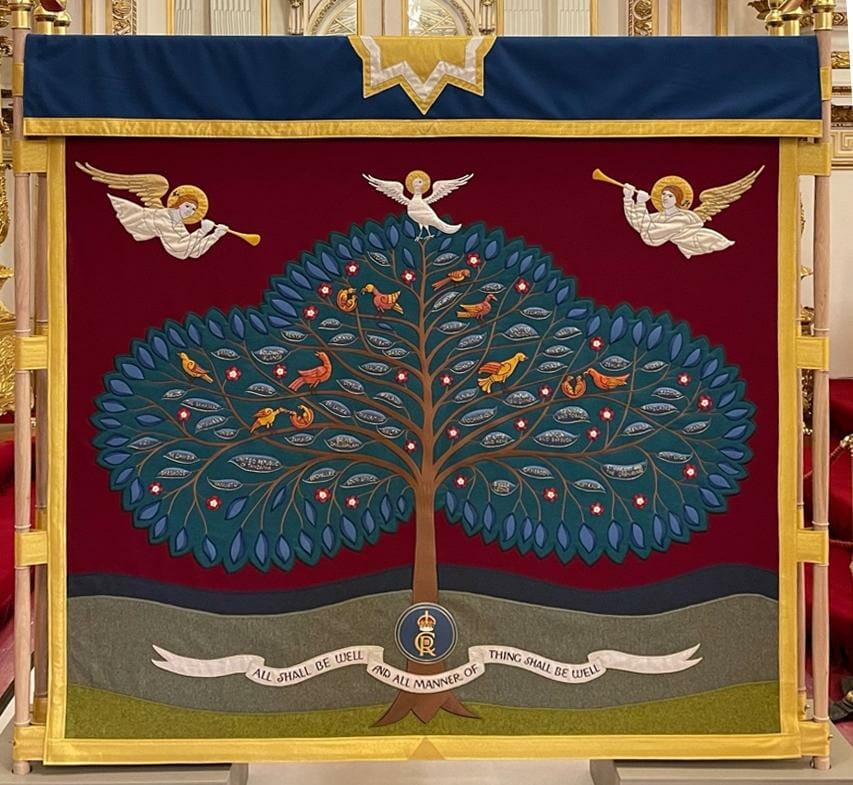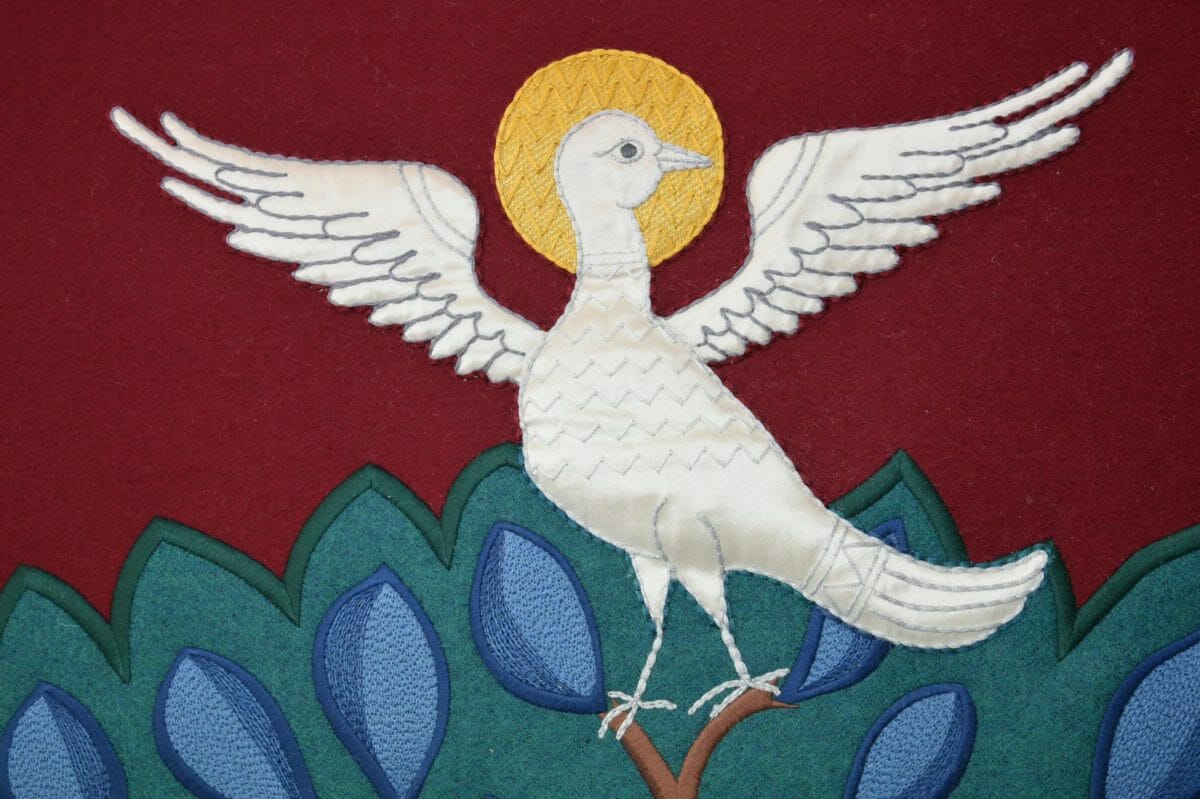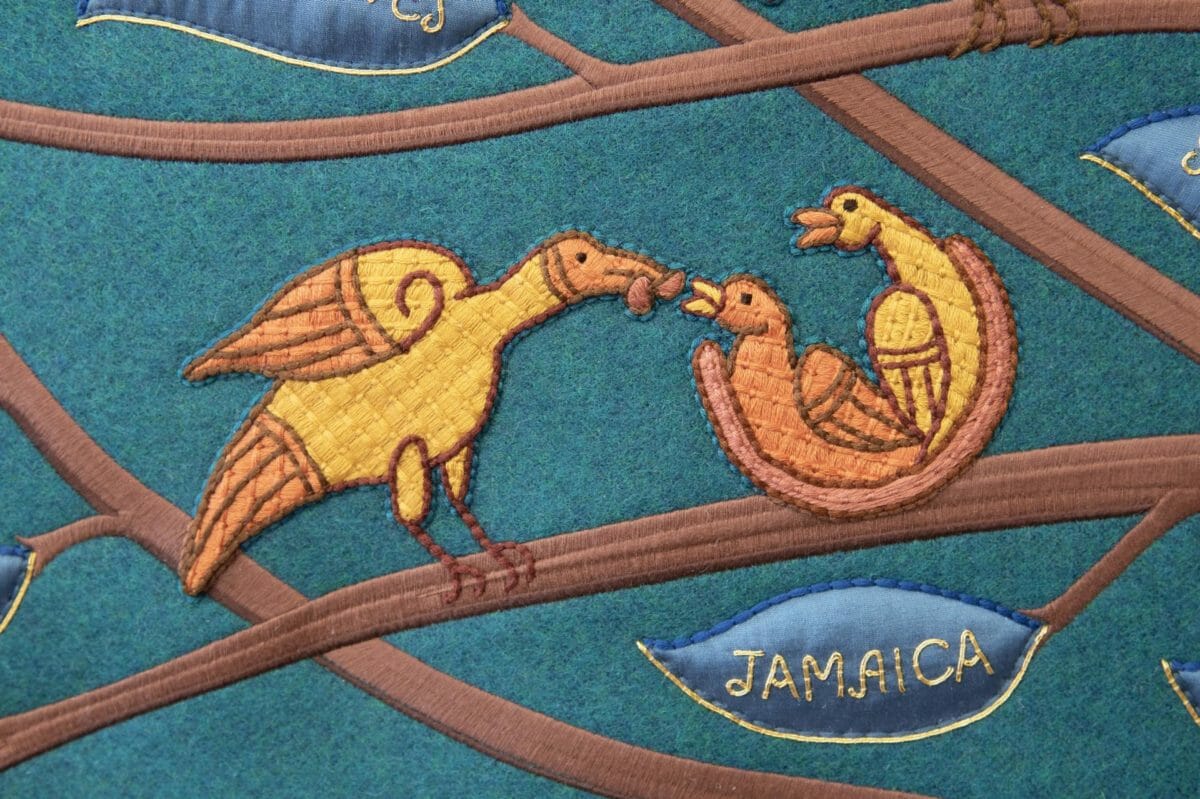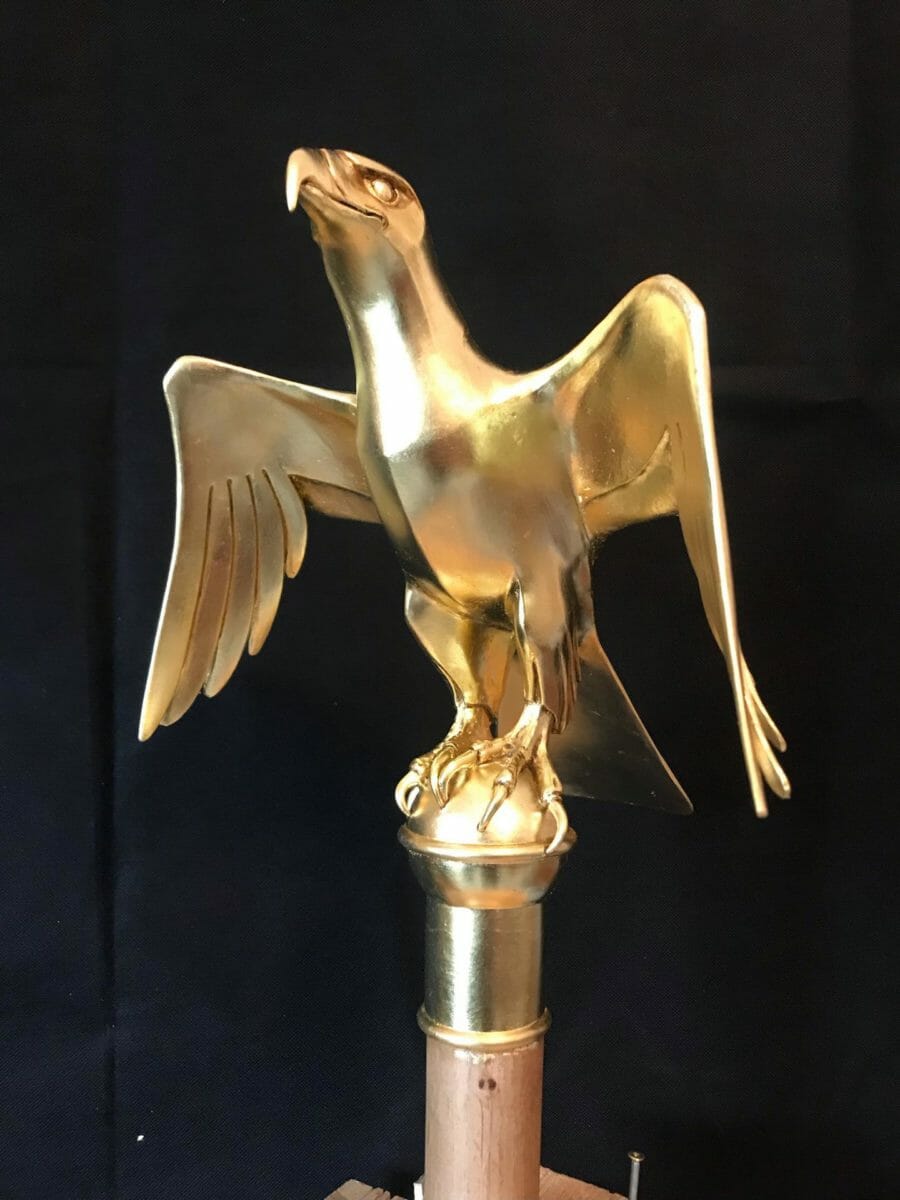Similar Posts
(Editor’s Note: The Coronation of King Charles III, this Saturday, will include important contributions from Orthodox artists. Alexander Lingas, Founder and Music Director of Cappella Romana, will lead the Byzantine Chant Ensemble in singing Psalm 71. And Iconographer Aidan Hart has designed the beautiful screen for the sacramental anointing, which he describes in the article below.
The sacred chrism itself is another contribution of the Orthodox Church. See photos of its consecration by the Patriarch of Jerusalem together with the Anglican archbishop here.
The coronation and anointing should be of great interest to Orthodox viewers, as these are among the most ancient religious rites, described even in the Old Testament. Sacramental anointing of a monarch was practiced as a sacred mystery by the Orthodox Church until the 20th century. Today no Orthodox monarchs remain – sacramental anointing of a Christian monarch still occurs in only two countries – Great Britain and Tonga. Saturday’s coronation may be a unique opportunity to witness this oldest and rarest of holy rites. -A.Gould)
It is not often that one receives a phone call from a king’s private secretary asking if you can design something for a coronation. But this is what happened to me in November last year; the last coronation in Britain was in 1952, over seventy years ago, for Queen Elizabeth II.
The request was to design three large fabric screens that would be processed into the sanctuary at the appropriate time and surround the King on three sides during his anointing. The anointing with holy oil—made in this instance in the Holy Land and blessed by the Orthodox Patriarch of Jerusalem—is the most sacred moment of the coronation. All the other elements of the service, to be held at Westminster Abbey, are open to public view – which includes world-wide television coverage—but this moment is traditionally veiled.
The King asked that the design elements of the main screen be derived from a stained glass window at the Chapel Royal, St James’s Palace, which depicts: a tree bearing the names of all the Commonwealth countries; a dove; two angels; the sun; the king’s cypher; and a quote from the 14th century English anchoress, Julian of Norwich (1343–c.1416): ‘All shall be well, and all manner of thing shall be well.’
Five months later, and the screens are now completed and ready for the coronation. Andrew Gould, editor of OAJ, has asked me to write a short explanation of the design, how the screens were made, and the meaning of the different elements.
First, the material and technique. The base cloth areas are of felt woven in England from New Zealand and Australian wool (the aim was, wherever possible, to use Commonwealth sourced materials and craftmanship). On top of this was applied embroidery and applique. To ensure everything was done in time, the hand embroidered elements were executed separately and then stitched on. This work was executed with consummate skill by students and teachers, past and present, of the Royal School of Needlework, London.
Due to time constraints, the tree outline and trunk were executed by machine embroidery. The larger elements, such as angels, dove, sun and ground, are applique in silk or wool, and in the case of the angels and dove, with some embroidery was applied on top for patterning. The two side veils, and the reverse of all three, bear a large cross of blue, red and gold. Their design and colours are inspired by the remarkable Cosmati floor of the abbey sanctuary, laid down in 1268, and on top of which the coronation will occur. These crosses are hand stitched applique, with gold thread embellishments.
And what of the symbolism in the tree? It is a union of two themes: first, the anointing and meaning of kingship, and second, the Commonwealth, as a family association dear to the King’s heart. The dove of course represents the Holy Spirit, and holy anointing in Scripture is the bestowal of the Holy Spirit for a given ministry, such as Solomon’s anointing by Zadok the priest and Nathan the prophet. The two angels, blowing trumpets, affirm that worship on earth is participation in heavenly worship. The sun, situated in the heavenly blue pelmet, has three rays to indicate the unity and distinction of the Holy Trinity, one God in three Persons. This unity in distinction is the basis for all else in the image, in particular, the unity and distinction of the fifty-six member states of the Commonwealth of Nations, represented by the tree with its leaves.
The Tree represents in general the Tree of Life, and in particular, the Commonwealth of Nations. It has always struck me that the Greek word for cross that is frequently used in Orthodox hymns also means tree and wood—xylo. The wood of the Cross becomes the Tree of Life. Similarly, one of the roles of a king is to lay down his life for his people. A number of Orthodox sainted kings of England have done just this, such as St Edward Martyr (d. 978) and St Oswald (d. 641). King Charles III is unlikely to have to die for his nation, but he is well known for his tireless labours in founding and supporting numerous charities, not least the Prince’s Foundation School of Traditional Arts, which runs one of the fullest, albeit part-time, programmes for training in icon painting in the West.
A tree consists of distinct branches and leaves, but all comprise a single tree, hence its use to symbolise the Commonwealth of Nations, a free association of independent nations united with common values. The fifty-six inner leaves are of padded silk cloth, embroidered in gold thread with the names of the Commonwealth countries. The branches intertwine (except for one, missed by the machine embroidery and too late to correct—see if you can spot it!). This interweaving reflects the Celtic contingent of the Commonwealth. On the principle of harmony between distinct elements, I tried to draw and place each leaf within its space among the branches so that it related to its particular space.
The lettering is a good example of how, when it came to deciding details, it was important to work closely with the embroiderers. This ensured that the work capitalized on the strengths, and limitations, of the medium. In fact, I am finding in general that a medium’s limitations are more interesting than its strengths. My original designs had shaded lettering, but this was not possible using golden thread at this scale. So we went instead for the double couched gold thread of even thickness that you see illustrated, but we retained the playful style of the classical Latin script of my original design.
The birds were included to add to the joyful atmosphere that I was trying to create. The birds move freely in the midst of a tree, which is more static than birds, but still alive as it grows and responds to changes in its environment.
In general, my design aim was to reflect the King’s—and his late Mother’s—approach of uniting the old with the new, or to put it more accurately, of continuing a dynamic tradition into the present. This of course is the same challenge that all iconographers face in our times.
I was keen to let the embroidery stitching speak for itself, and therefore did not constrain the embroiderers to imitate naturalism or painting. I was taken how the complexity of the Bayeux embroidery (incorrectly called a tapestry) was derived from a very limited range of stitches. By changing the direction and colour of this stitch, they created an harmonious, complex and dynamic symphony. So, after explaining this principle to the embroiderers, I asked them to come up with samples of some stitch types that they thought might work with the birds. A few were too obvious an attempt at naturalism and too fussy, but the one chosen I think works wonderfully. It was a joy to work with these craftspeople of consummate skill, so well versed in the vocabulary of traditional stitches, but willing to apply this in a contemporary but classical design.
There were many embroiderers involved, and this taught me the importance of working with one person who then organised the team. This person was Anne Butcher, Head of Teaching at the RSN, who was a joy to work with, along with her team.
I believe in the union of aesthetics with practical necessity. In architecture, for example, the dome and rounded arch are structural necessities with brick and stone, and yet their elegance derives from their obedience to the laws of physics. Likewise, it was wonderful to see how the embroiderers made the practical necessity of two rows of outline stitching for the birds into an aesthetic delight. The inner brown line was needed to contain the birds when they were being made individually, and the outer blue/green line was necessary to attach the bird to the felt backing. The result is a dual line that chromatically unites the bird with the background. This acts similarly to how the ‘halo’ andamenta of gold tesserae surrounding most Byzantine mosaic figures help to relate the figure to the background.
Time constraints necessitated the use of applique for the larger elements. We didn’t want these applied areas of cloth to appear flat and uninteresting compared to the texture of the embroidered sections, so the embroiders loosely padded the cloth to create an undulating surface and thus reflect light off the silk unevenly. Again, this is paralleled by mosaic, which plays with light by the varying the angle of the tesserae.
The King and government wished the whole coronation to be a splendid affair, while also showing a degree of restraint in light of the country’s economically straightened times. While humble but high-quality cloth was used for most of the work, gold thread was used to highlight the most important areas. It is hoped that the abbey lighting will pick this out, particularly as the veils are moving in procession.
The veils hang on oak frames expertly fashioned by the screens’ project manager, Nick Guttfreund. We wanted the raw materials to have as rich and relevant a history as possible, so he selected windfall oak from the royal Windsor Park.
Atop the poles that support the main screen are two splendid gilded bronze eagles, created by the sculptor Tim Royall. Eagles adorned the golden canopy held over the Queen during her anointing, so for continuity it was decided to include eagles in this work. The stylistic brief given to Tim for the eagles was to create two eagles that, like the tree and birds in the screen, distilled the essence of the eagle and not be a mere naturalistic representation. He did this superbly, especially by creating angular surfaces to create a greater contrast when the light reflected off the gilded surface.
Eagles in general represent a noble nature due to their strength and aristocratic appearance. Since they fly so high, they also represent the higher spiritual virtues. A king is called to be the first in service, and it is to this end that he, as also all Christians, are anointed by the Holy Spirit. The king’s cypher is therefore placed at the base of the tree; his role is to serve his people, not lord it over them.
Enjoy!
Aidan Hart
If you enjoyed this article, please use the donate button at the bottom of the page to support the work of the Orthodox Arts Journal. The costs to maintain the website are considerable.







Just stunning!
What a wonderful design – some feeling icon like in style!
This design of the Tree of Life and of the Commonwealth unites everyone, whether British or not, into a sense of unity for the earth/world, even as we seem to be torn apart.
Blessings to all.
Brilliant illustration of how Aby Warburg’s nachleben (afterlife of antiquity) resides in contemporary tree art.
Oh! Que Obra tão Bela!
Só um ser espiritual pode conceber uma Obra de tão rara Beleza.